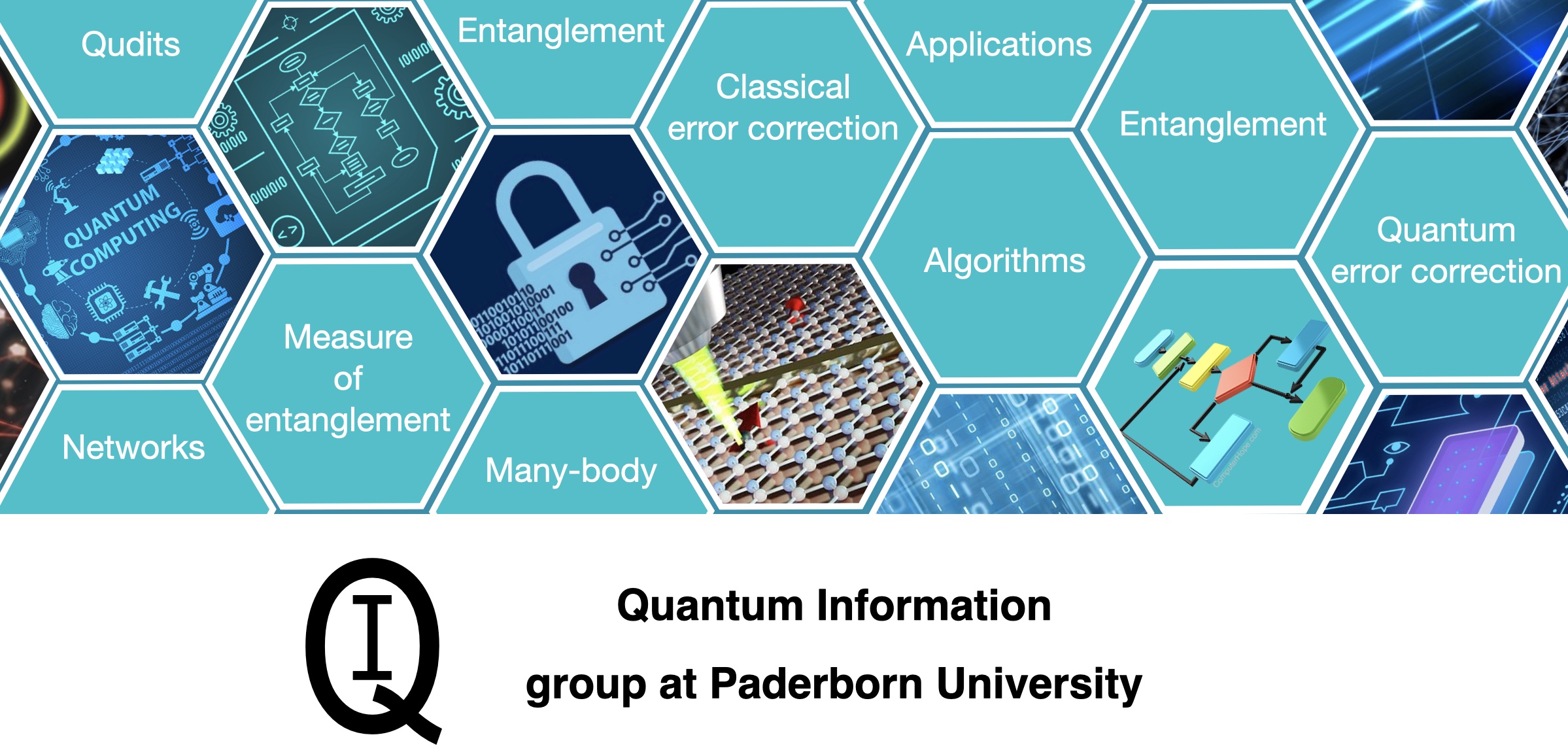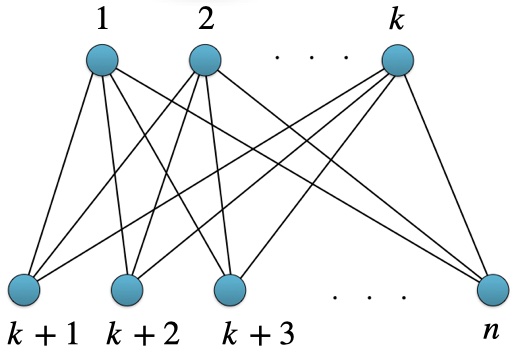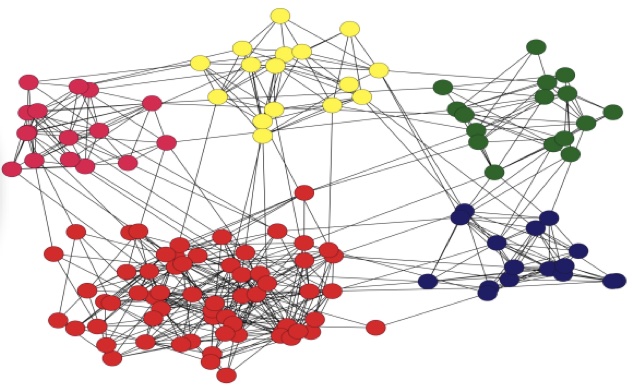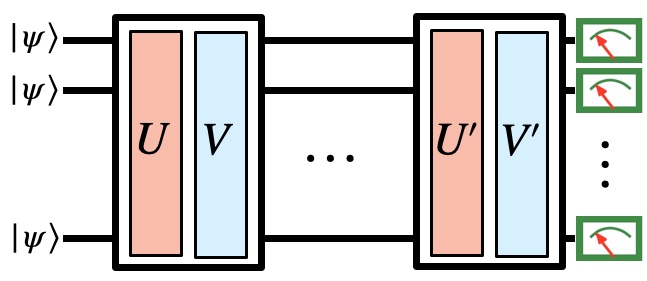



HomeRRRRResearchRRRRTeachingRRRR
Our group is concerned with research in quantum-information and computing and the intersection between these fields. There are research positions (Master's and Bachelor's theses) and internships if you are interested. For all inquiries concerning research positions and internships, please contact me:
zraissi[at]mail.uni-paderborn[dot]de
or
z.raissi2[at]gmail[dot]com
Overview:
Quantum mechanics is already 100 years old, during this time it was discovered that quantum physics has the potential to revolutionize information security, enabling quantum computers, and solving a number of outstanding problems in physics, computer science, chemistry, and biomedicine. The overarching goal of our group is to study and understand how to exploit quantum mechanics to develop new technologies that are otherwise impossible. The main interests the Quantum Information group at Paderborn University is concerned with are research on:
* ) Many-body Entanglement; Quantum entanglement
is the physical phenomenon that occurs when a group of particles are
generated, interact, or share spatial proximity in a way such that
the quantum state of each particle of the group cannot be described
independently of the state of the others. Entanglement is a primary
feature of quantum mechanics not present in classical mechanics.
Having access to an entangled state enables quantum
information-processing tasks that cannot be achieved classically,
such as teleportation, measurement-based quantum computation, and
entanglement-based quantum communication. Despite its importance, we
are still far from a complete understanding of entanglement.
Therefore, we have some questions in mind we would like to work on:
) Many-body Entanglement; Quantum entanglement
is the physical phenomenon that occurs when a group of particles are
generated, interact, or share spatial proximity in a way such that
the quantum state of each particle of the group cannot be described
independently of the state of the others. Entanglement is a primary
feature of quantum mechanics not present in classical mechanics.
Having access to an entangled state enables quantum
information-processing tasks that cannot be achieved classically,
such as teleportation, measurement-based quantum computation, and
entanglement-based quantum communication. Despite its importance, we
are still far from a complete understanding of entanglement.
Therefore, we have some questions in mind we would like to work on:
- How to measure / characterize / quantify entanglement of many-body quantum systems?
- What are the most useful states for a given quantum application?
- Finding connection between multipartite entanglement and classical and quantum error correcting codes.
- As entanglement cannot be created or enhanced using local operation and having classical communications, how one can classify the entangled states based on this fact?
- How can we generalise the EPR or Bell state to an arbitrary number of parties?
* ) Quantum Error Correction;
Similar to classical error correction, which plays a central role in
classical information theory, quantum error correction is similarly
foundational in quantum information theory. Both are concerned with
the fundamental problem of communication, as well as information
storage, in the presence of noise. However, there are primary
differences between classical and quantum error correcting codes,
namely:
) Quantum Error Correction;
Similar to classical error correction, which plays a central role in
classical information theory, quantum error correction is similarly
foundational in quantum information theory. Both are concerned with
the fundamental problem of communication, as well as information
storage, in the presence of noise. However, there are primary
differences between classical and quantum error correcting codes,
namely:
1. a quantum state can be in a superposition of multiple different classical states
2. any measurement of the superposition might collapse the quantum state into one of its classical components
3. copying quantum information is not possible due to the no-cloning theorem
We should note that error correction is especially important in quantum computers because efficient quantum algorithms are possible if we can stop imprecision. There are interesting open questions in this area as well:
- Is there any connection between classical and quantum error correcting codes?
- Can we use existing quantum error correcting codes to construct new ones?
- Can we use holographic models to construct quantum error correcting codes?
* ) Quantum
Networks;
are like the classical networks we use in everyday life to transmit
and share digital information. However, quantum
networks use uniquely quantum phenomena, like superposition,
no-cloning, and entanglement, that are not available to classical
networks. There are different ways of defining the entanglement
between neighboring qubits. So far, we have only used the method in
which one link between neighboring nodes is given by one pair of
entangled qubits, for example, atoms. In other words, one link in a
quantum network represents the entanglement between two qubits. As
quantum networks are an important element of quantum computing and
quantum communication systems, increasing our knowledge while
studying multipartite entangled states is very important. Therefore,
we can think of the following interesting questions in this area:
) Quantum
Networks;
are like the classical networks we use in everyday life to transmit
and share digital information. However, quantum
networks use uniquely quantum phenomena, like superposition,
no-cloning, and entanglement, that are not available to classical
networks. There are different ways of defining the entanglement
between neighboring qubits. So far, we have only used the method in
which one link between neighboring nodes is given by one pair of
entangled qubits, for example, atoms. In other words, one link in a
quantum network represents the entanglement between two qubits. As
quantum networks are an important element of quantum computing and
quantum communication systems, increasing our knowledge while
studying multipartite entangled states is very important. Therefore,
we can think of the following interesting questions in this area:
-What other methods of generating arbitrary quantum networks can we consider?
-How does measuring a single qubit changes the structure/model of a network?
-How to characterize the graphs by their robustness against losses and local noise?
* ) Quantum
Algorithms; A
quantum computer exploits quantum mechanical phenomena to operate,
which cannot be done by any machine based only on the laws of
classical physics. In mathematics and computer science, an algorithm
is a finite sequence of instructions or a step-by-step procedure for
solving a problem. The term quantum algorithm is usually used for
algorithms that seem inherently quantum or use some essential feature
of quantum computation, such as quantum superposition or
entanglement. In principle, running all classical algorithms on a
quantum computer is possible, however, the
advantage that quantum algorithms
have is running
on a quantum computer and achieving
a speedup, or other efficiency improvement, over any possible
classical algorithm. In this area of science, one can think of some
interesting projects and ideas that we can discuss more if you are
interested.
) Quantum
Algorithms; A
quantum computer exploits quantum mechanical phenomena to operate,
which cannot be done by any machine based only on the laws of
classical physics. In mathematics and computer science, an algorithm
is a finite sequence of instructions or a step-by-step procedure for
solving a problem. The term quantum algorithm is usually used for
algorithms that seem inherently quantum or use some essential feature
of quantum computation, such as quantum superposition or
entanglement. In principle, running all classical algorithms on a
quantum computer is possible, however, the
advantage that quantum algorithms
have is running
on a quantum computer and achieving
a speedup, or other efficiency improvement, over any possible
classical algorithm. In this area of science, one can think of some
interesting projects and ideas that we can discuss more if you are
interested.
